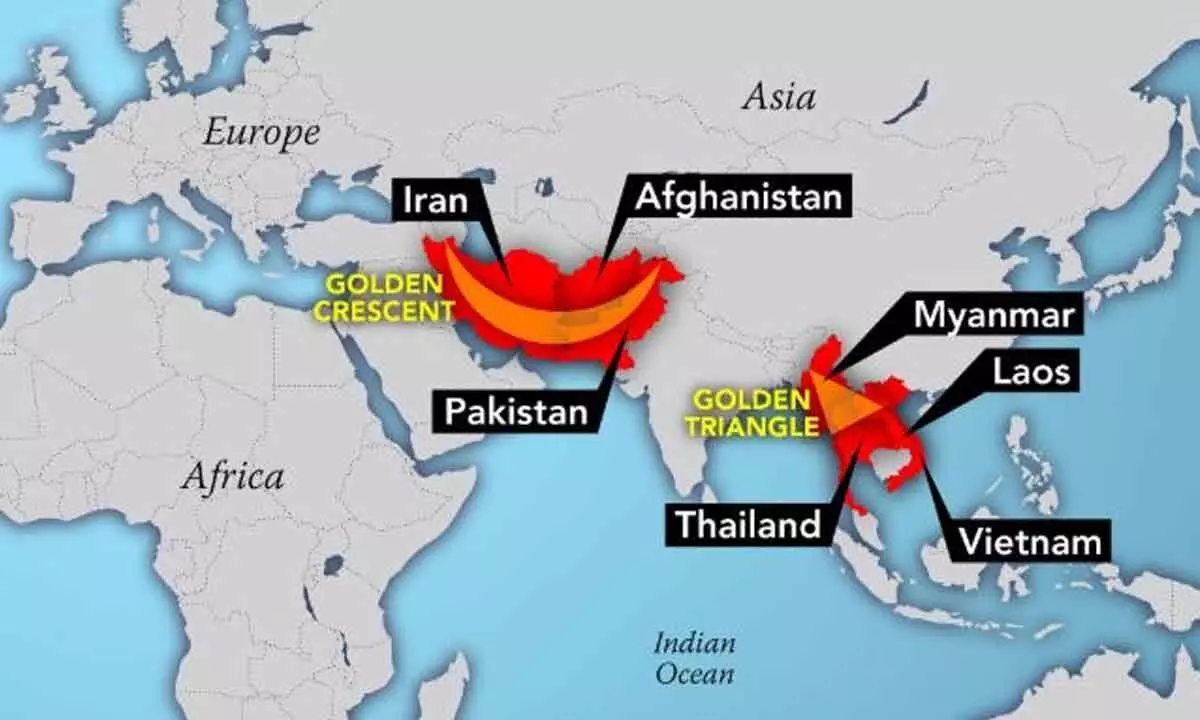Live
- Stokes motivates his team to put in extra effort, says England pacer Potts
- From overcoming setbacks to leading India in U19 Women’s Asia Cup, Niki Prasad's amazing journey
- Constitution debate: PM Modi hails 'Nari Shakti'; makes strong pitch for 'United Bharat’
- Bihar: Inquiry initiated against principal who went to buy veggies during school hours
- TN: DMK postpones executive meet due to heavy rains & Parliament session
- Porous silicon oxide electrodes can fix durability issues in batteries: Researchers
- Jalandhar civic polls: AAP promises launch of 100 e-buses, round the clock water supply
- Economic upliftment of rural women is priority of Tripura govt: CM Saha
- Rajmata Jijabai Trophy: Manipur move to top of the table, T.N register first win
- Italian envoy Baroli hoping to strengthen ties with India through football
Just In

Syndicates now use couriers, parcels, and postal services to smuggle drugs and deliver them. The increased use of couriers or postal services is directly linked to increased Dark Web activity in India. The quantity of drugs in parcels is usually limited to a few grams to avoid suspicion and interception by the law enforcement agencies
As per sources, Guwahati and Dimapur have seen a significant amount of heroin seizures that originated from the Golden Triangle. Myanmar's heroin and meth are smuggled into India at two entry points, Moreh in Manipur, and Champai in Mizoram. Interestingly, precursor chemicals such as ephedrine, acetic anhydride, and pseudoephedrine are sourced from locations in South India, including Chennai, and then transported to Kolkata and Guwahati via Delhi before being smuggled across the border to Myanmar, due to domestic security gaps.
Indian authorities have intensified their efforts to curb drug trafficking in the region, with the government of India and Myanmar signing a memorandum of understanding to combat drug trafficking in 2020. However, according to the annual report by the Narcotics Control Bureau (NCB) issued in 2022, drug trafficking through sea routes in the Arabian Sea and the Bay of Bengal accounts for about 70 per cent of the total illegal drugs smuggled into India, posing a significant challenge for the law enforcement agencies.
"Maritime routes used by international drug syndicates based in Pakistan and Afghanistan are expected to increase," said a senior NCB official. The NCB report also states that heroin is the most trafficked drug through the sea route, while marijuana, cocaine and other drugs are also seized. The Golden Crescent, on the other hand, is a major global opium production site in Afghanistan, Iran, and Pakistan, from where drugs are smuggled into India through Jammu and Kashmir, Punjab, Rajasthan and Gujarat. The drug smugglers have made potential markets and supply chain catalysts of hashish and heroin through these routes. Syndicates in these bordering areas are now using new digital tools and drones to smuggle drugs.
"One of the major drugs, heroin, is basically sourced from Afghanistan via the Golden Crescent and Golden Triangle. India's geographical location, sandwiched between the two, makes it an ideal route for the transportation of heroin. It infiltrates the country through the international, land and maritime borders, with the western international border along Pakistan being a focal point," said a senior NCB official. In addition, syndicates now use couriers, parcels, and postal services to smuggle drugs and deliver them. The increased use of couriers or postal services is directly linked to increased Dark Web activity in India. The quantity of drugs in parcels is usually limited to a few grams to avoid suspicion and interception by the law enforcement agencies.
The Indian government has intensified its efforts to curb drugs trafficking in the region, with the Border Security Force and other law enforcement agencies carrying out regular anti-drug operations along the borders. The drugs trade in these regions has significant implications for India's security and well-being. Drug addiction has a detrimental effect on the physical and mental health of individuals, and drugs trafficking often fuels violent crime and corruption. It also has a destabilising effect on countries and regions, with drugs traffickers often using their profits to fund terrorist activities. Efforts to combat drugs trafficking in these regions have been ongoing for several years, with the Indian government and international organisations working together to disrupt drugs trafficking networks.
These efforts include measures such as drugs interdiction operations, improving border security, and providing drugs treatment and rehabilitation services to those struggling with addiction. However, the drugs trade in these regions continues to thrive, with traffickers adapting to law enforcement efforts and finding new ways to smuggle drugs. "There is a need for a multi-pronged approach that not only focuses on law enforcement, but also addresses the underlying social and economic factors that contribute to drugs production and trafficking," said Gurmeet Nehra, research scholar at the Indian Law Institute.
Last year, the NCB had arrested 22 individuals, including software engineers, a financial analyst, an MBA, and one of their own personnel, who were part of a pan-India drugs trafficking network using the 'darknet' and cryptocurrency to courier narcotics to homes. Their arrests exposed three major drug markets, DNM India, Dread and The Orient Express, running on the hidden web world, after a four-month operation in Delhi-NCR, Gujarat, Maharashtra, Karnataka, Assam, Punjab, Jharkhand, West Bengal and Rajasthan. They were delivering LSD blots, psychotropic tablets, heroin, paste and liquid cannabis, cocaine, Alprazolam tablets, charas, capsules of Spasomoproxyvon, and imported ganja, sourced from countries such as the US, the UK, the Netherlands and Poland, using courier services and India Post.

© 2024 Hyderabad Media House Limited/The Hans India. All rights reserved. Powered by hocalwire.com







